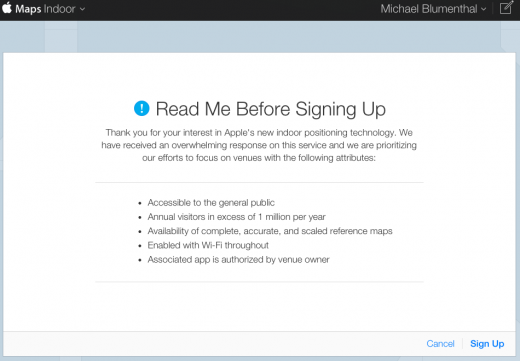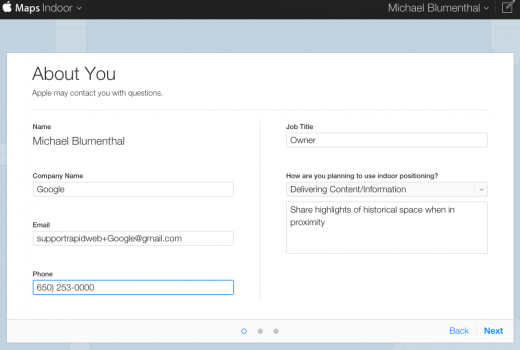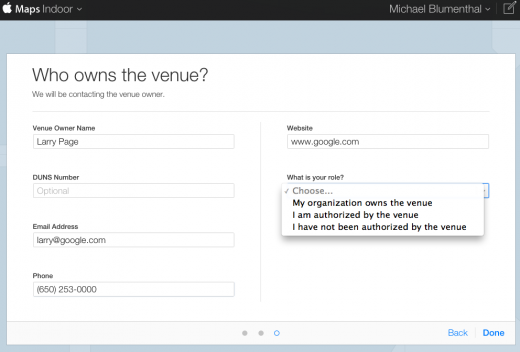Understanding Google My Business & Local Search
Apple All In on Indoor Mapping
Apple is slowly and steadily moving into the local space long occupied by Google and doing so with a slow and steady intention. I noticed with the rollout of their business listing product, Map Connect, that they were soliciting venues for their indoor Mapping project. Clearly they are looking for large scale venues with large traffic flows (minimum 1 million a year) to engage in the pre-release phase of the project.
It motivated me to research the project and I came up with an interesting timeline that speaks to their seriousness and to a lesser extent some of their goals in this arena. Clearly they view the space as important. And clearly do not plan on leaving it to Google.
The timeline:
March 2014: With Acquisition, Apple Looks Indoors for Future of Maps
The company has acquired WiFiSlam, a start-up company that helps to improve the accuracy of indoor maps and other services by locating the user’s position inside a building more accurately. Indoor maps look like they could become a new battleground between big companies seeking a cartographical edge on their rivals.
WiFiSlam could give Apple some of the smarts it needs to make iPhones better navigation devices when they are under a roof. WiFiSlam says its technology can pinpoint the location of a mobile device to “2.5m accuracy using only ambient WiFi signals that are already present in buildings.”
April 2014 Patent Indoor Directions (reported on 10/16)
..the application describes a method of seamlessly transitioning from a map displaying exterior elements like roads and buildings to one that shows indoor elements, like stores and restaurants.
This technology is designed to work with iBeacons, Apple’s Bluetooth Low Energy emitters designed to make iDevices location aware indoors.
An example of the patent application in action could be searching for an car parking space. Using its outdoor-to-indoor mapping technology, Apple Maps would first direct users to a car garage, then to a specific parking spot once inside.
Users would be able to specify specific criteria for their search, which would then be automatically initiated at some point in the journey, such as when the user comes within a predetermined distance of the designated destination.
Indoor mapping information would vary based on the type of building. For instance, if the indoor structure happens to be a mall, the supplemental information may include the location and name of each store, special sales, discount coupons, the shows and showtimes of an in-mall theater, and restaurant menus.
May 2014: Apple nabs indoor navigation company CEO
Apple has reportedly hired the cofounder and CEO of indoor location startup Wifarer for a “leadership role” — but did not acquire the company — in yet another sign that the iPhone maker is gearing up for a strong mapping push in its next-generation mobile operating system.
Wifarer cofounder Philip Stanger is said to have joined Apple in February, leaving his own company in the hands of a new CEO.
The company will likely leverage previous acquisitions Embark, HopStop, BroadMap, and Locationary to provide improved geolocation, more detailed point-of-interest data, and public transit routing.
June 2014 – Apple Is Launching A Vast Project To Map The Inside Of Every Large Building It Can
Apple has embarked on an ambitious program to use the sensors in its iPhones to map the large indoor areas of stores, offices, event spaces and commercial buildings,
Foeckl says. “It will be important to see how fast venue owners adapt to the technology and add venues. Google has more venues mapped at the moment, but it looks to be easier to add venues to Apple’s new indoor mapping service.”
iBeacons don’t specifically create indoor maps. Rather, Apple appears to be hoping to persuade building owners to upload a map of their space, and then iBeacons could in theory be used to automatically validate the map’s accuracy as iPhones receive their signals. That automation would be a huge step — currently, Google is validating its indoor maps by hand,
The new online application to participate:



© Copyright 2024 - MIKE BLUMENTHAL, ALL RIGHT RESERVED.

Comments
1 Comment
What’s going to stop Google from doing the same kind of automatic mapping and stay on top?
Comments for this post are closed.